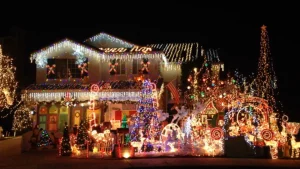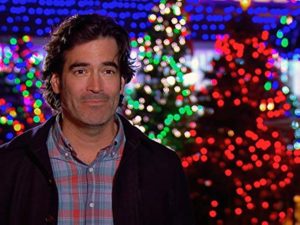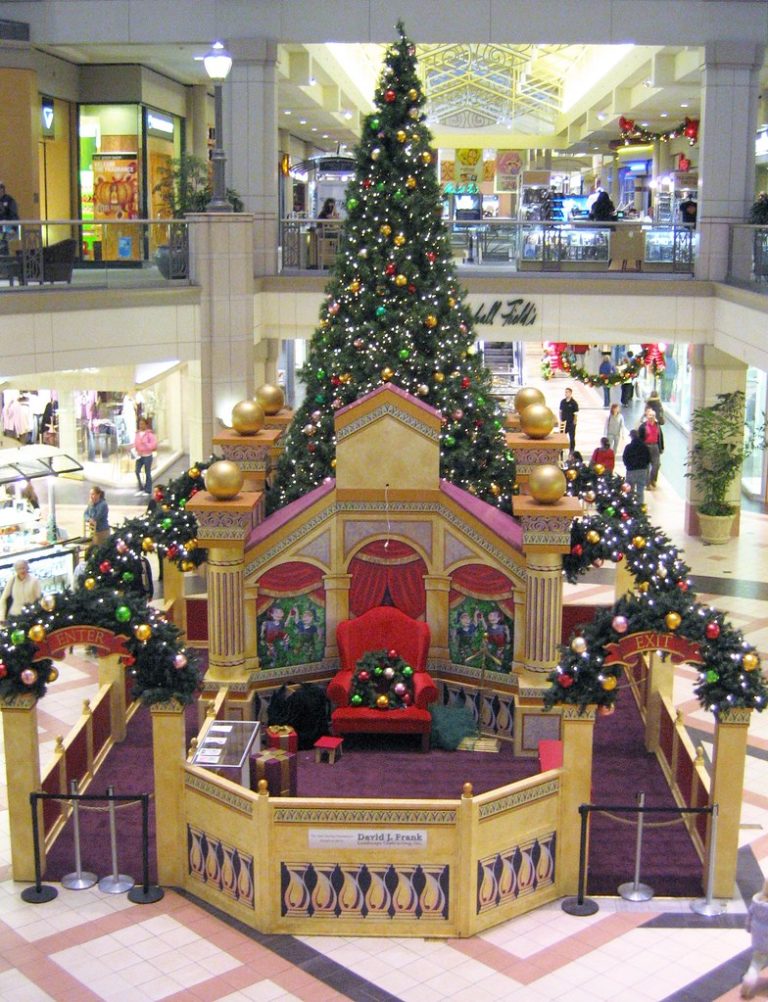On December 17, 2018, ABC aired a special episode of their hit series “The Great Christmas Light Fight”. This fifth episode of season six featured all-star families from previous episodes who had wowed viewers with their festive and spectacular displays. Despite being the least-watched episode of the season, it still garnered an impressive 3.85 million viewers.
Table of Contents
The families competed for a $50,000 prize and the coveted Light Fight trophy. Judge Carter Oosterhouse carefully examined each display, evaluating their use of lights, color, creativity, and storytelling. At the end of the episode, the winner was announced, and one family was crowned victorious.
The Great Christmas Light Fight Displays
The episode highlighted four families from different regions of the country who had been selected to participate in the special edition. First up were the Medhurst family from Greeley, Colorado, who had enchanted viewers with their snow-covered scenes and dazzling light displays in a past episode. Next were the Gilley family from Ballplay, Alabama, who stunned viewers with their unique handmade decorations and festive music. The Chuchla house in Phoenix, Arizona, was another featured home, which had wowed viewers with its colorful displays of lighted archways and playful decorations. Finally, the episode featured the Smith family from Temecula, California, who had made a name for themselves with their jaw-dropping synchronized light display set to music.
The Greeley Grizwalds in Greeley, Colorado of the Great Christmas Light Fight
The lights were synced to music every 30 minutes. (Note: The fictional family was spelled Griswold, but the Medhursts used Grizwalds to avoid copyright issues with the movie studio.) The Medhursts had moved to their home in 1998, but had been doing their larger display since 2002. Since 2007, the family had been syncing their lights up to flicker and dance to Christmas music that emitted from 90.3 FM, a local open frequency. The house had “maintenance years” and “signature years,” where a maintenance year meant the family focused more on what they already had rather than adding major installations. In one signature year, the family had added 30,000 more lights, helping push the total to 180,000 lights!
The Medhursts had lots of lights that they got from lots of different places – stores, online, and even directly imported. Visitors could find traditional winter wonderland staples such as reindeer (including the most famous of them all, Rudolph), snowmen, and Santa Claus, plus more unconventional Christmas decor like skiing bears, seals, rocking horses, and bumper cars. Many of these decorations were programmed to move as well.
Typically, the family tried to divide the property by different themes. The decorations covered the backyard, which was fenced in but still visible to those who stopped by. A portion of the backyard was made up to resemble a tree farm with different kinds of lighted trees. Bailey Medhurst was the youngest of two sons but the only one allowed to have creative control over a portion of the winter wonderland. His duty was to oversee the tree farm.
Medhurst never disclosed a dollar amount for the Greeley Grizwalds display. However, he did say his electric bill increased three-fold every holiday season. The Greeley Grizwalds display at 354 50th Avenue Court was lit up from 5:30 p.m. to 9:30 p.m. Sunday through Thursday and 5:30 p.m. to 10 p.m. Friday and Saturday. Lights were synced to music on 90.3 FM every 30 minutes.
During the display season, the family sometimes used the location for toy drives and other charitable events.
The Gilley Christmas lights in Ballplay, Alabama of the Great Christmas Light Fight
During the Christmas season, Mike Gilley and his older brother Donnie would sit on the front porch of the old family place and watch the faces of people as they walked through the front yard.
For a few weeks at the end of every year in Ballplay, an Etowah County community on the edge of Cherokee County, cars, trucks, and even buses would sometimes file past the Gilley place for a look at the lights. Christmas lights, locals would tell you, and then there were the Gilley lights.
There was the elephant, and the airplane, and the Ferris wheel with teddy bear passengers. There was the fish snapping at a morsel swimming just beyond its jaws. There was Noah’s Ark and a rainbow, and a helicopter carrying Santa Claus. And to greet each visitor was a manger scene, complete with Jesus in a cradle being rocked by Joseph and Mary, while she churned butter with her other hand.
The light display was the work of the Gilley brothers’ late father, J.C. Gilley, who died in January 2002. For almost 20 years, Gilley, a man with at most an eighth-grade education, built each light display by hand, mixing lights and melded metal wire together in his shop using no plans other than the ones he drew up in his mind. The brothers now kept the lights going, as a second generation made its way out to view them. And even then, ten years later, they marveled at the work their father did.
J.C. Gilley, his sons said, was something of a jack of all trades. He grew up in a sawmill family, later working as a mechanic in his shop in Piedmont by his 18th birthday. He built houses in Anniston, did some farming, and retired as a diesel mechanic in Gadsden.
His sons remembered him as a confident man who made them confident, who put people at ease, and liked to stay busy. And he loved Christmas. During the season, he and his wife Cassie would enjoy getting the family together, like most families. But it was important to him to remember what Christmas celebrated.
Neither of Gilley’s sons was sure exactly when their father started building his Christmas decorations. But the inspiration came from gas-powered model airplanes that he attached to a spinning contraption he made himself. The displays would take about a month to finish, and Gilley would set to work during the part of the year when he wasn’t otherwise occupied on the farm. For one piece, the elephant with the moving trunk, he consulted a picture in an encyclopedia. But he worked out a plan for doing it in his head.
As the yard outside the house he built in the 1940s filled up with lights each season, the number of people who ventured out began to grow. And so did the number of people who would give him donations to keep the lights going. Gilley would not charge admission, but he eventually did place a donation box for those who wanted to give.
J.C. Gilley, in the fall of 2001, added a final touch – a climbing elf, dressed in green and red. The almost life-sized figure didn’t work so well to start, and then its creator’s health began to fail. Even though he was too weak to get out and fix the elf, he gave Mike directions on repairing it. Gilley died just a few weeks after Christmas. Once the funeral was over, the brothers resolved they would keep the lights burning one more year. They set up a memorial to their father so visitors could write their own remembrances.
Since then, the only year the lights didn’t burn was 2009, when Cassie had a heart attack while setting up the lights. Her sickness extended into December, when she died. But the lights resumed the next year. The Gilleys say they still get people who turn up thinking the lights had long since stopped coming up each Christmas after the death of their parents. They have had visitors drive from as far away as Atlanta. It took about a month to get all the displays up, and they burned from Thanksgiving to the weekend after Christmas.
The David Chuchla’s Winter Wonderland in Phoenix, Arizona of the Great Christmas Light Fight
David Chuchla’s Winter Wonderland, located in Phoenix, Arizona, first opened for tours in December of 1994. With a team of one, David starts decorating the display on July 5th each year and works tirelessly until the end of Thanksgiving Day to ensure that everything is complete for the night’s grand opening. David takes pride in doing everything himself, to ensure that the decorations are perfect. The community has rallied behind David over the years, donating decorations, trees and other items to make the winter wonderland bigger and brighter. The display boasts more than 50 Christmas trees, each adorned with over 6,000 ornaments. Additionally, over 70,000 lights can be found both inside and outside the display, connected by over 100 extension cords. David also incorporates over 1000 animated figures to add movement and interest to the display. While the setup takes an impressive 450 man hours, it’s just as impressive how quickly it’s taken down, with it being fully packed away in three weeks time. David has three storage sheds and a 14ft box truck to keep all of the decorations, as he ensures that everything comes down each year to start fresh. With every display of this magnitude, there comes a price tag. David’s electric bill surpasses $1000 each year due to the massive amount of lights in the display. Additionally, David spends over $1200 on new decorations every year, starting his shopping for the next year immediately after the display comes down. Nevertheless, David is happy to bring joy to those who visit his Winter Wonderland and to spread some Christmas cheer to all.
The Smith Christmas lights in Temecula, California of the Great Christmas Light Fight
For most folks, putting up Christmas decorations in the front yard was something that took a day, maybe a few more, and occurred sometime after Thanksgiving. However, it was not so for the Smith family with Christmas lights in Temecula. Some of the family members had jotted notes down on what snowman should go where as early as March. That’s right —-March. That was because for the Smith family, Christmas decorations overtook the front yard of their home every year.

From the day after Halloween through the entire month of November, the Smith family worked to cover nearly every square inch of their yard with a seasonal display, including ice-skating penguins, Mrs. Claus’ bake shop, a Christmas countdown clock, a 25-foot Christmas tree, a reindeer flight school, a large Nativity scene, a row of tinsel trees, a gigantic snow globe, an elf village, and much more. The display was so impressive that it won one of the city of Temecula’s Christmas decoration awards for several years.
Todd Smith, patriarch of the Smith family, said the holiday effort had become a tradition that brought the family together —- including his mother-in-law, North Carolina resident Joanne Kalmar, who came to town to help co-produce the display.
Smith and Kalmar said they didn’t mind the show’s good-humored take on their annual endeavor and enjoyed working with each other. Smith, 40, a firefighter, was much of the muscle behind the production, which included draping 50,000 lights all over the yard, roof, and trees, and hoisting a huge star atop the house, nestled in a cul-de-sac.
Kalmar inserted her creative talents into the mix and demanded some Christmas decoration rules be followed to a T. The duo included the entire family in the effort each year, including Smith’s wife of 18 years, Heather, who taught at Pauba Valley Elementary in Temecula, and their two boys, Dylan and Joshua.
Also in the mix was Smith’s brother-in-law, Jason Kalmar of San Marcos, who painted elaborate background scenes to add to the depth of the display. Even Joanne Kalmar’s mother, Dorothy Loomer, lent a hand as the work unfolded in November.
The display remained in place through Jan. 1.
The Great Christmas Light Fight Season 6 Episode 6 Hosts
About Taniya Nayak – Host of the Great Christmas Light Fight
Taniya Nayak is a Boston-based interior designer and TV host who has been captivating viewers for over a decade with her inspiring designs and bubbly personality. Originally from India, Taniya moved to the United States with her family at a young age, and spent her childhood in the colorful state of Colorado. Her love for color and design was fostered by her parents, who encouraged her to express herself creatively from a young age.
After graduating from the University of Massachusetts Amherst with a degree in Business Administration, Taniya started her career in the design industry, working with various firms in Boston. She quickly made a name for herself with her eye-catching designs and impeccable attention to detail, and was soon recruited to appear on various home renovation shows. Over the years, Taniya has hosted multiple hit TV shows, including HGTV’s “Designed to Sell,” “House Hunters on Vacation,” and “Restaurant Impossible”.
Taniya’s design aesthetic is a unique combination of classic elegance and contemporary flair, with a bold use of color and unexpected details. Her designs have been featured in national publications such as Good Housekeeping, InStyle, and People Magazine, as well as on the sets of hit TV shows like “The Oprah Winfrey Show” and “The View”. In addition to her TV work, Taniya is also a sought-after speaker and design consultant, sharing her expertise with clients and audiences around the globe.
Despite her busy schedule, Taniya remains deeply connected to her roots and often draws inspiration from her childhood memories in Colorado. She also stays true to her Indian heritage, incorporating elements of Indian design and culture into many of her projects. Taniya’s passion for design, combined with her fun-loving personality and infectious energy, make her a force to be reckoned with in the design world, and a beloved personality on TV.
About Carter Oosterhouse – Host of the Great Christmas Light Fight
Carter Oosterhouse is an American television personality, carpenter, and model who has been carving out a career in the design industry for over two decades. Growing up in Traverse City, Michigan, Carter developed an interest in woodworking at a young age, and pursued a degree in construction management from Central Michigan University.

After college, Carter landed a job as a carpenter on the TLC series “Trading Spaces,” and quickly became a fan favorite for his laid-back demeanor and expert craftsmanship. He went on to host numerous design shows, including HGTV’s “Carter Can,” “Red Hot and Green,” and “Million Dollar Rooms,” among others.
In addition to his television work, Carter is a successful entrepreneur, having launched his own construction company, Carter Oosterhouse Construction, as well as an eco-friendly home and lifestyle brand, Carter’s Kids. Carter’s Kids provides outdoor play spaces and community gardens for underprivileged children.
Despite his success, Carter has never forgotten his roots, and has remained connected to his hometown in Michigan. He is also a frequent visitor to Arizona, where he has a home in Phoenix and has worked on several design projects. His love for the Southwest is evident in his designs, which often incorporate natural materials like stone, wood, and metal in warm, earthy tones.
Throughout his career, Carter has remained committed to promoting sustainable design and green living. He is a spokesperson for the Environmental Protection Agency’s Energy Star program, and has authored multiple books on eco-friendly design and living. His unique blend of expertise, charm, and commitment to sustainability has made Carter Oosterhouse one of the most beloved personalities in the design world.




